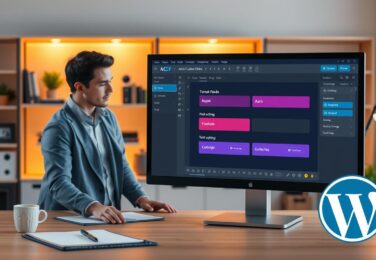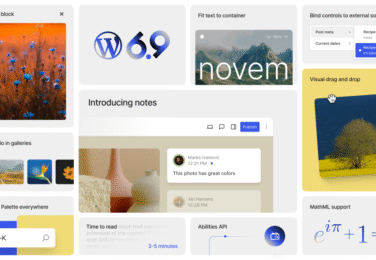The step by step guide for WordPress Development

Table of Content
Did you know WordPress powers over 40% of websites worldwide? It’s the most used CMS for businesses and brands. This means you have many options, from simple sites to complex custom solutions.
We’ll guide you through WordPress Development for Australian businesses. Our steps include planning, design, hosting, theme and plugin choices, and development basics. We also talk about when to use a WordPress developer versus off-the-shelf tools.
This guide is for small and medium business owners, marketing managers, and digital teams. It helps you navigate to a reliable delivery path. You’ll learn about scoping projects, choosing hosting and domains, and selecting themes. We also cover custom post types, hooks, and filters.
If you face technical challenges or need custom WordPress solutions, contact hello@defyn.com.au. Our experienced developers are ready to help.
Key Takeaways
- WordPress Development supports everything from blogs and portfolios to ecommerce and custom apps.
- A solid plan for wordpress website designers in Sydney and scope reduces cost and delays.
- Choosing the right host and domain affects speed for Australian visitors.
- Select themes and plugins carefully; know when to hire a wordpress developer.
- We cover essential development topics: CPTs, hooks, filters, security and performance.
Understanding WordPress and why it’s ideal for Australian businesses
We explain why WordPress is a great choice for Australian businesses. It offers flexibility and a wide range of themes, plugins, and services. We aim to help you understand its capabilities and next steps for WordPress Development and website design.
WordPress is a free content management system run by the WordPress Foundation and a global community. It uses PHP and MySQL or MariaDB. It also has a block editor called Gutenberg for easy content creation.
It has many features like content authoring, media management, and user roles. It also supports themes and plugins to add more functionality.
Benefits for small and medium businesses in Australia
One big advantage is its cost-effectiveness. The core software is free, and you can choose hosting and themes that fit your budget. It also supports localisation for Australian English and tax rules.
It’s flexible for various businesses, including service providers and healthcare. There’s a strong Australian community for WordPress Development and hosting.
Common use cases: blogs, ecommerce, portfolios and service sites
WordPress is great for different types of sites. It’s perfect for content marketing and blogs to generate leads.
For ecommerce, WooCommerce is a great option with Australian payment options. Creative sites can showcase work with clean designs. Service sites can use booking systems and CRM integrations.
With the right hosting and customisation, WordPress is a solid choice. Working with a WordPress expert can make the process faster and ensure your site looks good on all devices.
| Use Case | Core Benefit | Typical Plugins / Tools |
|---|---|---|
| Blog / Content Marketing | Fast publishing, SEO-friendly structure | Yoast SEO, Gutenberg blocks, WPForms |
| eCommerce (WooCommerce) | Local payments, tax and shipping rules | WooCommerce, Stripe/Australian gateways, ShipStation |
| Portfolio / Creative | Visual presentation, gallery controls | Elementor or block templates, Smush, NextGEN Gallery |
| Service & Booking Sites | Bookings, memberships and CRM links | Bookly, MemberPress, HubSpot or Salesforce connectors |
Planning your WordPress website design and project scope
We start every project by setting clear goals. These goals guide our design choices and help us focus. This approach saves time and keeps costs stable.
Defining goals, audience and website functionality
First, we identify the main business goals. These might include generating leads, making sales, or boosting brand awareness. We focus on mobile-first design for Australian users.
We then identify our audience by their behaviour, industry, and device use. We note which groups need specific content or login areas. We also list the features needed, such as ecommerce or CRM integrations.
Mapping content, user journeys and conversion points
We create a simple sitemap with key pages like home, services, and contact. We map user paths to conversion points.
We design clear calls to action and funnels for each audience. We plan the content types needed, including copy and imagery. We also include SEO meta tags for search goals.
Budgeting and timelines for a WordPress project
We set realistic budgets for each project. Simple sites cost in the low four-figure range. Custom builds and ecommerce projects cost more, up to five figures.
We use standard timeline phases: discovery, design, development, and QA plus launch. We allow for revisions and approvals. A disciplined change-request process prevents scope creep.
For bespoke features, we engage a skilled wordpress developer early. This helps estimate costs and phase work sensibly. It makes the project predictable and client-friendly.
| Phase | Typical Duration | Deliverables | Budget Range (AUD) |
|---|---|---|---|
| Discovery | 1–2 weeks | Goals, sitemap, audience segments, functional spec | $1,000–$3,000 |
| Design | 2–4 weeks | Wireframes, visual design, responsive mockups | $2,000–$8,000 |
| Development | 2–8 weeks | Theme build, custom wordpress solutions, integrations | $3,000–$30,000+ |
| QA and Launch | 1–2 weeks | Testing, performance tuning, go-live checklist | $500–$3,000 |
| Ongoing support | Monthly | Updates, backups, minor changes | $150–$1,500/month |
Choosing hosting and domain for performance and reliability
We pick hosting and domains for fast, secure, and easy sites. Good choices mean less downtime, better search rankings, and easier future updates. Here’s a look at hosting types, performance factors for Aussie visitors, and setting up domains and SSLs.
Types of hosting
Shared hosting is cheap for simple sites. It’s easy to manage but has limited resources. It can slow down under heavy traffic.
VPS hosting offers more control and resources. It’s great for growing sites needing custom settings. We suggest VPS for sites expecting more traffic or custom work.
Managed WordPress hosting, like WP Engine or Kinsta, offers updates, caching, and support. It’s perfect for sites focusing on speed and security. It makes maintenance easy.
Key performance considerations for Australian visitors
Use servers in Australia or a CDN with Aussie PoPs to reduce latency. Local hosting improves site speed for Aussie users.
Enable caching, PHP-FPM, and OPcache. Set PHP memory limits and database settings right. These steps improve site performance and responsiveness.
Use a CDN like Cloudflare for faster mobile performance. Monitor TTFB and Largest Contentful Paint. Quick mobile loading is key for responsive design.
Domain selection and SSL setup
Choose a domain that’s easy to remember and matches your brand. For Aussie businesses, a .com.au domain is best for trust and legal reasons.
Use HTTPS with Let’s Encrypt or your host’s SSL. Make sure all traffic is HTTPS and consider HSTS for security. Set DNS TTL values for your site and CDN.
For important sites, balance cost with performance. Managed WordPress hosting with local support makes maintenance easy. It also gives access to a WordPress expert for help.
Selecting the right WordPress theme for responsive WordPress design
We look for a theme that focuses on performance and accessibility. A good theme helps with design and reduces the need for later customisation. It’s important to start with mobile-first layouts and accessibility features.
What should we check first?
- Responsiveness: check how it looks on different devices.
- Semantic markup: makes sure content is easy for screen readers and search engines.
- Plugin compatibility: test with popular plugins like WooCommerce and Yoast.
For simple sites, free themes on WordPress.org might be enough. But for more complex sites, premium themes from ThemeForest or Elegant Themes offer more features. We consider cost, update frequency, and community feedback when making our choice.
When does a framework or lightweight starter theme make sense?
- For big design changes, a lightweight theme with a child theme is safer.
- Frameworks like Genesis are great for custom builds.
- Builder-heavy themes might slow down your site, so customisation is key.
How do we validate long-term support?
- Look for recent updates and check if it works with the latest WordPress and PHP.
- Make sure there are good support channels and licence terms for client handovers.
- Test the theme in a staging environment with plugins and sample content.
Practical checklist for choice and handover
| Criteria | What to verify | Why it matters |
|---|---|---|
| Responsiveness | Mobile-first CSS, defined breakpoints, responsive images | Improves user experience and supports faster wordpress website design launches |
| Accessibility | ARIA roles, keyboard nav, semantic headings | Reduces legal risk and broadens audience reach |
| SEO readiness | Clean markup, schema support, SEO plugin compatibility | Boosts organic visibility with minimal extra work |
| Support & updates | Recent commits, changelog, developer response time | Ensures longevity and smooth maintenance by a wordpress developer |
| Customisation effort | Child theme friendly, modular CSS, uncluttered template files | Reduces future wordpress theme customisation time and cost |
Installing WordPress and initial configuration
We start by picking the best way to install WordPress. You can use a managed host or control panel for quick installs. Or, you can go for manual setup for more control. Both ways aim to create a secure, fast WordPress site ready for your content.
Choosing the right path depends on your needs. For fast setups, one-click installers on cPanel or managed hosts are great. For custom setups, manual installation from WordPress.org is the way to go.
After WordPress is up, we set up the basics. We use a friendly URL structure for permalinks. We also set the time zone and date to match Australia/Sydney or your area. It’s important to create strong admin passwords and add editors for content teams.
Security is key from the start and continues with maintenance. We change the default login URL, limit login attempts, and use two-factor authentication. We also disable file editing in wp-config.php and check file permissions. Ensuring HTTPS and supported PHP and MySQL versions is also essential.
To grow and track your site, install an SEO plugin and connect Google Analytics or GA4. Creating a staging environment helps test updates before they go live.
- One-click installers: fast, sensible defaults, ideal for standard wordpress development workflows.
- Manual installation: full control, better for custom hosting and advanced configurations.
- Initial settings: permalinks, time zone, users, SEO plugin and analytics.
- Security at setup: login protection, 2FA, DISALLOW_FILE_EDIT, HTTPS and supported server stacks.
| Task | One-click Installer | Manual Install |
|---|---|---|
| Speed of setup | Minutes with recommended defaults | Longer, dependent on configuration |
| Control | Limited server-level tweaks | Full access to wp-config and DB |
| Best for | Small businesses and quick launches | Custom environments and complex wordpress development |
| Security steps available | Host tools and plugins | Manual hardening and file permission control |
| Recommended by | Managed hosts and WordPress specialists | Developers and agencies for bespoke wordpress website design |
When updates or issues come up, we follow a strict maintenance routine. If your team is busy with other tasks, consider hiring a WordPress expert for ongoing checks.
Customising themes and WordPress theme customisation
We help businesses make theme tweaks that keep their sites stable and easy to update. Good wordpress theme customisation starts in the Customiser or the theme options panel. Here, you can change logos, colours, and typography without touching core files.

How do we make safe edits? Follow a short checklist:
- Use the WordPress Customiser for header, footer and colour settings where available.
- Prefer settings stored in the customiser or the theme’s options panel over direct file edits.
- Document every change and keep a changelog in Git for custom wordpress solutions.
Why use a child theme? A child theme keeps your custom CSS and template overrides safe when the parent theme updates. Create one, enqueue styles correctly with wp_enqueue_style and push changes to a staging site first.
What about updates and testing?
- Test parent theme updates in staging before merging to live.
- Keep a version-controlled branch for significant tweaks handled by a wordpress developer.
- Restore points and backups reduce risk during theme or plugin updates.
Which files should you know? The template hierarchy matters for targeted edits:
- index.php, header.php and footer.php for global structure.
- single.php and page.php for content templates.
- archive.php for lists and taxonomy views.
How do we limit PHP edits? Keep changes minimal and secure. Escape output, use WordPress functions like get_template_directory_uri and rely on hooks, filters and template parts to add functionality without altering parent files.
Practical steps for teams seeking custom wordpress solutions:
- Create a child theme and connect it to your Git repository.
- Make UI changes in the Customiser or theme options panel.
- Add small PHP changes only via hooks or template parts.
- Run updates on a staging environment and review logs before deploy.
When projects grow, bring in a wordpress developer with experience in wordpress development. They can implement robust patterns and keep the site maintainable.
Building pages and content with page builders and Gutenberg
We help teams make smart choices when building pages. The right editor can speed up work and make maintenance easier. We show how Gutenberg and visual builders fit into different workflows, helping businesses create consistent content.
Which editor is best? We compare their strengths to help you choose the right tool for your project.
Gutenberg is WordPress’s native block editor. It’s lightweight and gets regular updates. It’s great for simple layouts and custom blocks. Teams that value speed and simplicity will like it.
Elementor and similar builders like Beaver Builder and Divi offer rich visual controls and templates. They make designing pages fast and easy. But, they might add extra assets and could lock you in, so test them first.
Choosing an editor depends on your team’s skills, design needs, and maintenance plans. Agencies making many sites benefit from templates and a clear component library. This reduces repeat work and limits plugin reliance.
How do we make sections reusable? Reusable blocks and templates keep content consistent and speed up publishing.
- Create reusable blocks in Gutenberg for CTAs, testimonials, and promo banners.
- Build block patterns and page templates to enforce layout rules across pages.
- With page builders, set up global widgets and saved templates to control design tokens.
What are the best content practices? Clear structure and readable copy improve engagement and accessibility for all users.
- Use headings (H1–H3) to map content hierarchy and aid scanning.
- Write short paragraphs and bullet lists for quick comprehension.
- Optimise images in WebP when possible, add concise alt text and supply responsive sizes.
- Include internal links and clear CTAs to guide user journeys and conversion points.
- Test keyboard navigation and contrast to meet accessibility expectations.
We suggest a standard template and component library to speed up content creation. This approach reduces rework during plugin development and keeps custom code manageable.
| Attribute | Gutenberg | Elementor / Visual Builders |
|---|---|---|
| Performance | Lightweight output, fast load times for most use cases | Rich features with larger asset footprint; needs optimisation |
| Design control | Good for modular layouts and custom blocks | Pixel-perfect controls, advanced animations and templates |
| Reusable elements | Reusable blocks and block patterns | Global widgets and saved templates |
| Maintenance | Tighter integration with core updates; simpler long-term upkeep | May require plugin updates and careful compatibility checks |
| Best fit | Teams prioritising performance and standardised wordpress website design | Design-led projects needing high fidelity and rapid prototyping |
WordPress Development
We create detailed workflows for WordPress Development that connect design and engineering. Our team explains the front-end and back-end tasks. This way, business leaders know what to expect and what a wordpress developer will deliver.
Front-end tasks
- Convert visual designs into HTML, CSS and JavaScript.
- Ensure responsive layouts and accessibility for Australian audiences.
- Optimise performance by minifying assets and lazy-loading images.
- Integrate templates into theme files for consistent page rendering.
Back-end tasks
- Develop PHP logic, database design and custom queries.
- Create REST API endpoints for headless setups or integrations.
- Configure servers, caching and deployment pipelines using Git.
- Maintain local and staging environments with tools such as Docker or Local by Flywheel.
We suggest planning content structures early. Use register_post_type and register_taxonomy to model products, events or case studies. This makes templates, archives and search filters simpler.
Leverage custom fields via Advanced Custom Fields or meta boxes for structured data. This makes content editing predictable for clients and supports tailored templates.
Hooks, filters and extendable features
- Use add_action and add_filter to extend behaviour without changing core files.
- Create shortcodes, custom Gutenberg blocks and REST API routes for bespoke interactions.
- Follow WordPress coding standards, sanitise input and escape output for security.
- Document functions and file structure so future teams can maintain or extend features.
When a plugin cannot meet unique requirements, we propose custom wordpress solutions. This often involves modular features that any wordpress developer can test and update.
For projects needing new features, our approach to wordpress plugin development focuses on performance, compatibility and clear versioning. We build testable modules and include documentation. This way, clients and developers understand how systems work together.
WordPress plugin development and choosing plugins wisely
We make smart choices and focus on quality when we extend WordPress sites. Picking the right plugins saves time and keeps maintenance low. Custom code protects your business’s unique needs. Here’s when to use plugins, how to make a simple plugin, and what to check before you deploy it.
When to use plugins vs custom code
For common features like SEO, caching, and backups, use trusted plugins. They save time and leverage the expertise of WordPress communities like Automattic and Yoast.
Go for custom code when your business rules are different, a plugin adds too much, or licensing and maintenance costs are high.
Think about the ongoing updates needed. Custom solutions might reduce plugin reliance but need constant developer work and version control.
Creating a basic plugin structure
Start with a single PHP file that includes a plugin header and clear namespacing. Add hooks for activation and deactivation to set up or clean up options.
Use WordPress APIs like the Options API, Transients, and the REST API. Make sure to enqueue scripts and styles correctly to avoid conflicts.
Include a README, changelog, and licence file. This helps teams and future experts understand your plugin’s purpose and support needs.
Security, performance and plugin compatibility checks
Check plugins by reviews, active installations, and recent updates. Make sure they’re compatible with the current WordPress version before adding them to production.
Test in a staging environment to check memory use, slow queries, and plugin conflicts. Watch the database size and identify heavy hooks or long queries.
Audit the plugin code for sanitisation, nonces, and capability checks. Ensure file handling is secure and avoid plugins that write unsafe files to the filesystem.
Practical maintenance workflow
Keep a shortlist of approved plugins for critical sites. Maintain an inventory for maintenance and patching to keep updates predictable.
When things get complex, consider getting help from a WordPress expert. They can help decide between custom code or a curated plugin set.
| Checklist | Why it matters | Action |
|---|---|---|
| Active installs & ratings | Shows community use and real-world stability | Choose plugins with high installs and current reviews |
| Recent updates | Indicates ongoing support and security fixes | Prefer plugins updated within the last 12 months |
| Performance impact | Direct effect on page speed and hosting costs | Test in staging; measure memory and query times |
| Security practices | Prevents injection, XSS and privilege escalation | Audit code for sanitisation, nonces and capability checks |
| Maintenance overhead | Determines long-term wordpress maintenance effort | Estimate update cadence and support needs |
| Custom vs plugin fit | Balancing speed to market with technical debt | Use plugins for standard features, custom code for unique logic |
Integrations: ecommerce, marketing and third-party services
We create integrations that link commerce, marketing, and business systems. This makes stores run smoothly and teams work together better. Our focus on wordpress development includes handling GST, accurate shipping costs, and reliable payment processing for Australian needs.
What should you set up first? Start with WooCommerce configuration and core settings. Use AUD as the default currency and define tax rates that follow ATO rules. Create shipping zones that match your delivery network. Always test in sandbox mode before going live.
How do we handle storefront needs?
- Product setup: simple, variable and digital products with inventory management and download controls.
- Extensions: Stripe and PayPal for card payments, Afterpay or Zip for BNPL and ATO-friendly reporting plugins.
- Shipping: Australia Post integration or third-party courier connectors, shipping classes and checkout cost estimates.
Which marketing and analytics tools do we connect?
- CRMs: HubSpot, Salesforce and Zoho via plugins or middleware to sync leads, customers and orders.
- Email platforms: Mailchimp, ActiveCampaign and Campaign Monitor for automated flows and post-purchase sequences.
- Analytics: Google Analytics 4, Google Tag Manager and conversion tracking for Google Ads and Meta campaigns.
When do we recommend custom integrations?
Choose custom wordpress solutions when standard plugins can’t meet your needs. Custom work reduces plugin bloat and keeps performance high. Our wordpress plugin development services create tailored connectors for your CRM, ERP, or unique shipping logic.
What about compliance and bookkeeping?
- Ensure receipts show GST where applicable and track refunds against tax obligations.
- Configure digital product tax treatments according to Australian rules.
- Test order exports to accounting packages and verify invoice formatting for BAS reporting.
How do we manage the checkout experience?
We test payment gateways in sandbox mode, verify 3D Secure flows and validate refunds and chargebacks. A skilled wordpress developer will set up retry logic, payment notifications and clear order emails. This ensures customers can complete purchases without hassle.
Summary of integration choices and practical steps:
| Area | Recommended Tools | Key Setup Steps |
|---|---|---|
| Store platform | WooCommerce | Set AUD, tax rates, shipping zones, product types, inventory |
| Payments | Stripe, PayPal, Afterpay/Zip | Enable sandbox, configure webhooks, test refunds and 3D Secure |
| Shipping | Australia Post, Sendle, third-party couriers | Set shipping classes, live rates, zone rules and weight-based costs |
| CRM & Email | HubSpot, Salesforce, Zoho, Mailchimp, ActiveCampaign | Map fields, sync contacts and orders, automate post-purchase journeys |
| Analytics | Google Analytics 4, Google Tag Manager | Implement event tracking, conversion tags and attribution for ads |
| Custom work | WordPress plugin development, bespoke APIs | Build lightweight connectors, follow coding standards, test performance |
We suggest a staged rollout: first, set up core integrations and run tests. Then, add advanced automations. For complex migration or bespoke needs, work with a team experienced in wordpress development and custom wordpress solutions. This avoids disruptions and keeps data safe.
Optimising for performance and SEO best practices
We focus on making pages fast and improving search rankings for Australian businesses. Fast pages lead to lower bounce rates and better conversions. We use technical fixes and content tuning to boost Core Web Vitals and search indexability.
- Enable full-page caching at server level or with a good plugin. Use Redis or Memcached for dynamic queries.
- Compress responses with GZIP or Brotli. Minify and defer non-critical JavaScript and CSS to reduce render-blocking scripts.
- Optimise images by serving WebP where supported, create responsive image sizes and apply lazy loading for off-screen assets.
- Use a CDN to serve static files, configure cache headers and implement asset versioning to avoid stale files.
- Run audits with Lighthouse and GTmetrix, then prioritise fixes that move LCP, INP/FID and CLS metrics.
On-page SEO, schema and structured data
- Use clean, descriptive URLs. Optimise title tags and meta descriptions around user intent for target queries.
- Structure content with semantic headings and add descriptive alt text to images to help accessibility and search crawlers.
- Implement schema.org markup for Organisation, BreadcrumbList, Product and LocalBusiness. Add structured data through theme templates or a trusted plugin.
- Generate XML sitemaps and submit them to Google Search Console and Bing Webmaster Tools to speed indexing.
Local SEO strategies for Australian businesses
- Claim and verify your Google Business Profile. Keep NAP (name, address, phone) consistent across directories and your site.
- Create location pages for major Australian cities and regions, targeting localised keywords and regional intent.
- Collect genuine customer reviews and build local backlinks from industry partners and chambers of commerce.
- Use local schema and include opening hours, service areas and pricing where relevant.
We pair these optimisations with disciplined wordpress maintenance to keep performance steady over time. When projects require deeper change, a wordpress expert can audit custom code, improve server configuration and tune plugins for sustained gains.
For ongoing wordpress development, we recommend a monthly review cycle. This tracks Core Web Vitals, search rankings and traffic. Small, regular updates protect gains and prevent regressions.
Security hardening and backup strategies
We handle security hardening and backup plans so clients can manage and bounce back quickly after issues. Our method combines preventive steps with regular checks to safeguard sites from wordpress development and custom plugin work.

What common threats should you plan for?
- Brute force attempts on logins.
- Vulnerable or abandoned plugins and themes.
- Cross-site scripting (XSS) and SQL injection attacks.
- Outdated WordPress core and weak server permissions.
How do we mitigate these risks?
- Keep WordPress core, themes and plugins updated as part of routine wordpress maintenance.
- Deploy a Web Application Firewall such as Cloudflare or Sucuri to block common exploits.
- Enable two-factor authentication, strong password policies and limit login attempts.
- Remove unused plugins and restrict file permissions at the server level.
Backup strategy essentials:
- Automated daily backups of files and database, stored offsite on Amazon S3 or similar with versioning.
- Incremental backups for large stores or enterprise sites to reduce storage and restore time.
- Retention policies that match recovery point objectives and compliance needs.
Why test restores?
Backups are only useful if they work. We test restores on a staging environment often to check they’re good and to see how fast they can be done. This is key for any wordpress expert or team doing managed services.
Access control and user role management:
- Apply the principle of least privilege. Grant editors or authors only the capabilities they need.
- Maintain an approved access list for hosting and admin accounts. Rotate credentials when staff change.
- Use auditing tools to review user accounts, scheduled tasks and authentication logs.
Operational checklist for teams:
| Item | Action | Frequency |
|---|---|---|
| Core, theme and plugin updates | Apply to staging first, then deploy; document changes | Weekly |
| Backups | Full daily backup with incremental snapshots; store offsite with versioning | Daily |
| Restore testing | Perform test restore on staging and validate data integrity | Monthly |
| Access review | Audit user roles, remove inactive accounts, rotate credentials | Quarterly |
| Firewall and scanning | Review WAF logs, run malware scans and patch vulnerabilities | Weekly |
When to call us: if you need hands-on help with wordpress plugin development, deeper wordpress development tasks or ongoing wordpress maintenance a specialist team can implement the plan and run tests for you.
WordPress maintenance and ongoing updates
We keep WordPress sites safe and stable with clear steps. Regular checks lower risks and technical issues. Our method mixes automation with manual checks to avoid site problems.
What does a good update workflow look like?
- Test updates in a local or staging environment before production.
- Maintain a compatibility matrix for plugins and themes.
- Automate minor security patches, review major core or plugin upgrades manually.
- Schedule maintenance windows and notify stakeholders in advance.
How do we monitor site health and uptime?
- Use uptime monitors like UptimeRobot or Pingdom and performance tools such as New Relic.
- Run security scans with Wordfence or Sucuri and track errors with Query Monitor.
- Alert on critical incidents, log changes for debugging and audit trails.
When should you hire outside help?
Get a wordpress expert for custom integrations, ecommerce growth, or advanced skills. For complex templates or plugins, a wordpress developer is best. Consider retainers for ongoing maintenance and security.
Practical steps to reduce downtime:
- Document a maintenance plan with service-level expectations.
- Keep a changelog and rollback procedures for every update.
- Test backups regularly and run restore drills to confirm recovery time.
If you’re facing customisation challenges or need help, reach out to our team at hello@defyn.com.au. We offer support from routine upkeep to unique builds.
| Area | Recommended Action | Tools |
|---|---|---|
| Update Workflow | Staged testing, automate minor patches, manual review for major changes | LocalWP, Git, WP-CLI |
| Monitoring | Uptime, performance and security checks with alerting | UptimeRobot, New Relic, Wordfence |
| Backups & Recovery | Daily backups, monthly restore tests, documented rollback | UpdraftPlus, BackWPup, Off-site storage |
| When to Hire | Custom development, integrations, ecommerce scaling, DevOps gaps | Experienced wordpress developer or wordpress expert on retainer |
Conclusion
We’ve explored the WordPress Development journey. We looked at understanding the platform, planning, and choosing hosting. We also talked about selecting and customising themes, building content, and using development best practices.
These include custom post types and hooks. We covered plugin strategy, ecommerce and marketing integrations, performance tuning, and security hardening. Plus, we discussed ongoing WordPress maintenance.
Simple and practical tips are key. Plan well and document your needs. Use staging environments, version control, and testing before going live.
Balance plugins with custom development to avoid issues. Focus on security, backups, and performance from the start. Set up automated backups, regular checks, and uptime monitoring.
If you need expert WordPress support, contact hello@defyn.com.au. We offer custom solutions, performance audits, and managed maintenance.
We’re here to help Australian businesses. We handle technical stuff so you can focus on growing and serving your customers.










